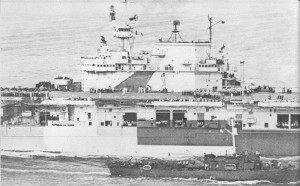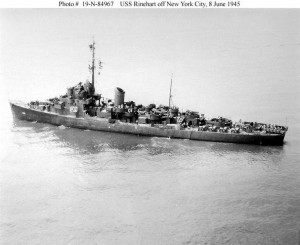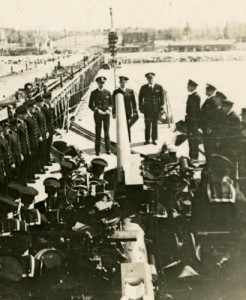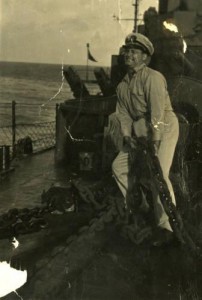WOODY’s WWII MILITARY SERVICE AND USO TOURS DURING VIETNAM
Lt. Commander Wayne Woodrow Hayes of the United States Navy in 1944
Yes, Woody is known for his coaching, but many do not know of his military service during World War II. Woody enlisted in the United States Navy in July 1941, eventually rising to the rank of Lieutenant Commander. He asked for active duty and served his country for five years. Woody could have stayed at Naval Station Great Lakes outside Chicago for the whole war, but he volunteered for sea duty.
 “People talk about how devoted Woody is to football,” Mrs. Hayes once observed. “He was just as dedicated to the Navy. Why, we had been married only five days when he asked for sea duty. He didn’t get it at once, but he did request it. Stevie was nearly nine months old before Woody saw him for the first time.”
“People talk about how devoted Woody is to football,” Mrs. Hayes once observed. “He was just as dedicated to the Navy. Why, we had been married only five days when he asked for sea duty. He didn’t get it at once, but he did request it. Stevie was nearly nine months old before Woody saw him for the first time.”
In 1946, he was honorably discharged as a lieutenant commander, having commanded the PC 1251 in the Palau Island invasion and having served on the destroyer escort Rinehart in both the Atlantic and Pacific operations.
Throughout his coaching career, military icons, in fact, played a large part in the manner in which his teams operated, down to running plays being named “Patton” for General George Patton. Former Ohio State All-American fullback Pete Johnson remarked, “Patton #1 through #6—those were all my plays.”
 Woody commanded USS Ukiah (PCC-1251) a Control Submarine Chaser and saw combat in the Palau Island invasion.
Woody commanded USS Ukiah (PCC-1251) a Control Submarine Chaser and saw combat in the Palau Island invasion.
 Woody also commanded the destroyer-escort USS Rinehart in both Atlantic and Pacific operations, with a crew of 15 officers and 201 enlisted.
Woody also commanded the destroyer-escort USS Rinehart in both Atlantic and Pacific operations, with a crew of 15 officers and 201 enlisted.
 Woody Hayes (on right facing camera) taking command of the USS Rinehart from Captain Engle during World War II, ca. 1943. Hayes enlisted in the United States Navy in July 1941, and obtained the rank of Lieutenant Commander during World War II. He commanded PC 1251 in the Palau Islands invasion and the destroyer-escort USS Rinehart in both the Atlantic and Pacific operations. Born Wayne Woodrow “Woody” Hayes in Clifton, Ohio, in 1913.
Woody Hayes (on right facing camera) taking command of the USS Rinehart from Captain Engle during World War II, ca. 1943. Hayes enlisted in the United States Navy in July 1941, and obtained the rank of Lieutenant Commander during World War II. He commanded PC 1251 in the Palau Islands invasion and the destroyer-escort USS Rinehart in both the Atlantic and Pacific operations. Born Wayne Woodrow “Woody” Hayes in Clifton, Ohio, in 1913.
Woody Hayes with a group of fellow officers on board the USS Rinehart during World War II, ca. 1943. Hayes enlisted in the United States Navy in July 1941, and obtained the rank of Lieutenant Commander during World War II. He commanded PC 1251 in the Palau Islands invasion and the destroyer-escort USS Rinehart in both the Atlantic and Pacific operations.
 Woody Hayes playfully trying to move an anchor on the deck of the USS Rinehart, a ship he commanded during his service with the United States Navy in World War II, ca. 1943.
Woody Hayes playfully trying to move an anchor on the deck of the USS Rinehart, a ship he commanded during his service with the United States Navy in World War II, ca. 1943.
Great video of Woody from a BBC Documentary and you can see his military background was an influence on his coaching and life.
WOODY VISITED THE TROOPS IN VIETNAM 4 TIMES!
During the Vietnam War, he made four trips overseas to visit with and entertain deployed servicemen and women.
Hayes is pictured with Col. David E. Ott, an expert on field artillery tactics in Vietnam.
Hayes in Vietnam, 1967
Hayes made four separate trips to Vietnam during the war to support and entertain the U.S. troops.
Hayes in Vietnam, 1967
|
Two of Many Stories of Woody Taking to Time With US Service Members in Vietnam I worked at Na Trang for three weeks on pouring concrete and special construction projects. I then received my final orders to be stationed at Phu Loi to work in my MOS 67N20 – advanced helicopter crew chief/mechanic. The Phu Loi base camp is approximately 30 miles north of the capital Saigon. We worked 7 days a week 12 hour shifts. For a few months I worked the 12 hour night shift, then I would be switched to the day 12 hour shift. We were permitted to attend church on Sunday mornings for one hour. I never missed church and always went with a friend from my company. While in Vietnam I saw Billy Graham, Bob Hope at a special secured USO assembly area about 10 miles from Phu Loi. Also, four times we had USO shows at our base camp. One late night, coach Woody Hayes visited our base camp when I was working the 12 hour night shift. I was working with my crew on the top of a UH1D Huey helicopter when I saw a person dressed as an officer, but with no rank identification. Woody said hello and ask if he could talk to me. I said sure I will come down to talk. Woody said please stay up there, that will be just fine. Woody ask me if I knew who he was and I said no. Woody introduced himself as the OSU football coach from Columbus. Woody ask me my name, where I lived and wanted to know if it would be OK that he contact my family. He wanted to let my family know that I was OK and that we talked briefly. I gave Woody the information he needed including the phone number and name of our Mother. He promised he would contact Mother as soon as he returned to Columbus, and he did. Mother wrote me and told me she talked with coach Woody Hayes. US Army Specialist/4 LES W. CONKEY “Along with your fellow Ohioans, I am truly grateful for your efforts as a soldier and a Buckeye.” Mike Demko kept his word. During the recent Christmas holiday, he was visiting family in Maryland. He and his daughter, a Marine captain on leave from duty in Iraq, arranged a visit to Walter Reed Army Medical Center. They took more than 1,000 cookies as well as an Ohio State flag to hang in one of the recovery wards. He thought he’d let Gordan Gee (then President of OSU) know he’d planted the flag for OSU at Walter Reed. But he thought Gee ought to know about the legacy he carried as well. He told of the time he spent in Vietnam in the late 1960s, when Woody Hayes visited his unit as part of a USO tour. “The visit to Walter Reed was my way of paying Woody back for being there 40 years ago,” he wrote. USMC, MIKE DEMKO |
NOTE: Information about and specific comments made by Woody Hayes and others were drawn from the following sources: Woody Hayes: The Man & His Dynasty, edited by Mike Bynum; I Remember Woody: Recollections of The Man They Called Coach Hayes, by Steve Greenberg and Dale Ratermann; and Woody Hayes and the 100-Yard War by Jerry Brondfield; and The Ohio State University Library.






